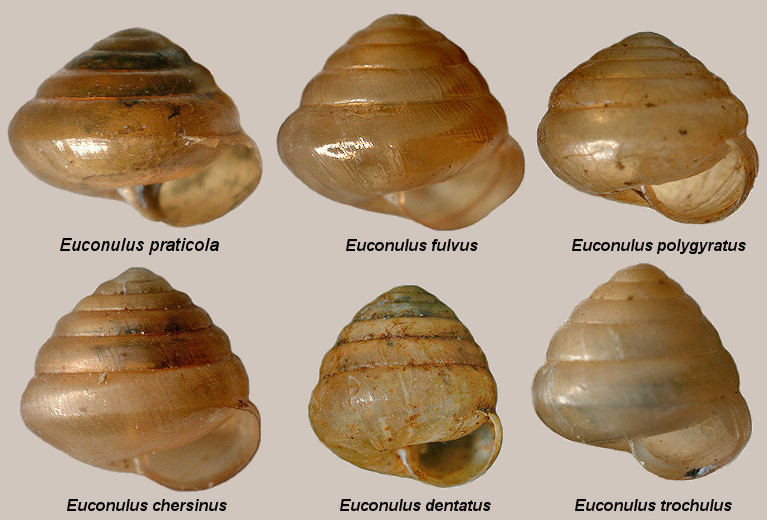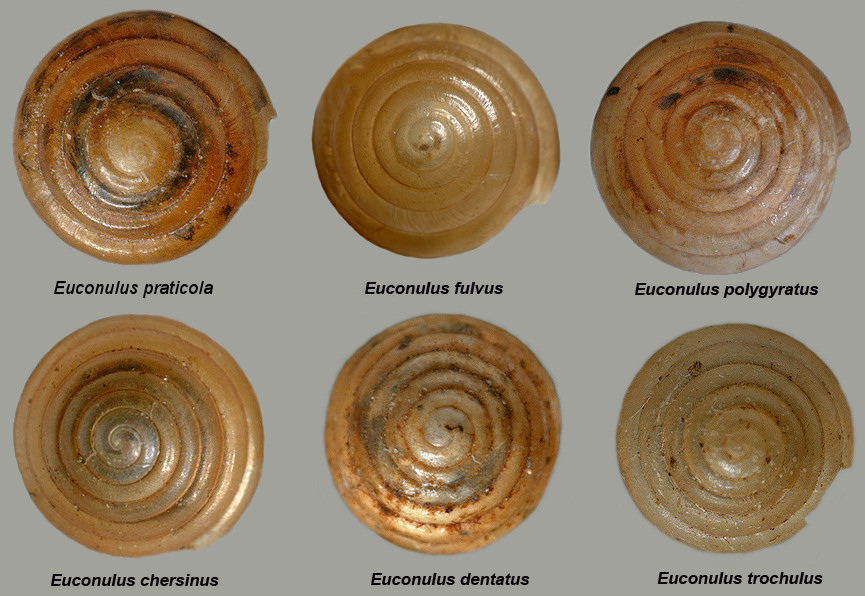|
 |
|
Original digital images by David Kirsh with image editing by Bill
Frank |
|
Upper row L to R: E.
praticola
(Reinhardt, 1883) Marsh Hive,
Bennington Co., VT: max. height (H) 2.1 mm, max. width (W) 2.8 mm,
5.2 whorls; E. fulvus (Müller, 1774), Brown Hive, Bennington
Co., VT: H 3.2 mm, W 3.4 mm, 6.5 whorls; E. polygyratus (Pilsbry,
1899), Fat Hive, Bennington Co., VT: H 2.4 mm, W 2.75 mm, 6.8
whorls. |
|
Lower row L to R: E. chersinus (Say, 1821), Wild Hive, Duval
Co., FL: H 2.35 mm, W 2.5 mm, 6.8 whorls; E. dentatus (Sterki,
1893), Toothed Hive, Jackson Co., FL: H 2.75 mm, W 2.5 mm, 6.9
whorls; E. trochulus (Reinhart, 1885), Silk Hive, Duval Co.,
FL: H 2.4 mm, W 2.45 mm; 6.6 whorls. |
|
 |
|
 |
The genus
Euconulus, known as Hives in the vernacular, has always been an
irksome taxon for collectors of eastern American landsnails. There
are fewer characters than usual available for analysis as the shells
are, at first glance, lacking in sculpture and of a monotonous size
and shape as adults. This predicament is aggravated by various
degrees of allometric shell growth and a predominance of juvenile
shells in most suites. Distinctions among species are subtle and not
usually explicit in the literature. Because of these barriers to
species-level identification, published identifications and
distributions are open to skepticism in many instances.
On the other hand, limiting observations to adult shells, one
may distill characters as species-level indicators: profile in
apertural view, tightness of coil (apical view), shell surface
(luster/texture/microsculpture/coloration), and the presence of
internal "teeth" - the latter albeit in only one species.
Nekola (2004:
29, 31) seems to have been the first to recognize a “trichotomy” in
northern US Euconulus. Analyzing a phenomenal 242 sites
personally collected in NE Wisconsin and the adjacent southern Upper
Peninsula of Michigan (slightly overlapping the latitude of
Bennington Co., VT), he recognized the European species E. alderi,
along with E. fulvus and E. polygyratus. The last of
these was for years regarded as a subspecies of E. chersinus.*
Reconciliation of Nekola’s descriptions with the figures and text of
Pilsbry (1946: 235-242) and the British work by Kerney and Cameron
(1979: 148-149) indicates that the same three names were applicable
to the Vermont snails figured in the "northern" (upper) row of each
panel above. E. alderi is dark, shiny, and has a low profile;
E. fulvus (also see page two) is taller, paler, and more
matte in texture; and E. polygyratus has a rounder profile
and tighter coil than the other two.
Although Nekola and others, e.g., Kerney and Cameron 1979 and
Grimm 1996, used the name Euconulus alderi (Gray in
Turton, 1840) for this Holoarctic species, G. Falkner et al.
(2002) recently treated E. alderi as a synonym of E.
trochiformis (Montagu, 1803), a European forest-dwelling
species, and resurrected the name E. praticola (Reinhardt,
1883) for this dark, flat, glossy wetland species. R.G. Forsyth of
the Royal British Columbia Museum, Vancouver, Canada followed
Falkner et al. and dubbed it the "Marsh Hive" since it was
not treated in Turgeon, Quinn, et al. (1998). Inasmuch
as "praticola" means "dweller in fields," its brand new
vernacular name is much more apt than the "scientific" one.
Likewise, among the "southern" species in the lower
row of each panel:
E. chersinus is more cinnamon-colored than E. trochulus,**
which is less tightly-coiled and has a less convex base. E.
dentatus*** is tightly coiled like E. chersinus but has a
uniquely tapering profile in contrast to the more triangular
outlines of the other two taxa. The internal teeth of the
aptly-named E. dentatus (as seen at
Euconulus dentatus (Sterki, 1893) Toothed Hive)
may be absorbed by the adult animal. Similarly these structures may
be obscured or eroded
in less-than pristine shells of any size, but it appears this
feature is not essential for the identification of adult material.
The extremely fine spiral sculpture of these species is best
seen in E. praticola This character may eventually be analyzed
in all six taxa with SEM but will not be further discussed at
present. |
* Hubricht (1965: 5) elevated it to specific rank.
** E. polygyratus was considered subordinate to E.
fulvus or E. chersinus for three-quarters of a century
until given full species rank by (Grimm, 1971: 53).
*** Like the preceding two captioned
taxa, treated as a subspecies (of E. chersinus) from the time
of its description until Hubricht (1983: 13) raised it to a full
species.
Falkner, G., T.E.J. Ripken, and M.
Falkner, 2002. Mollusques continentaux de France, Liste de
référence annotée et bibliographie. Patrimoines Naturels 52 (Muséum
National d'Histoire Naturelle, Paris): 1-350.
Grimm, F.W., 1971. Annotated checklist of the land snails of
Maryland and the District of Columbia. Sterkiana 41: 51-57.
Grimm, F.W.,
1996. Terrestrial molluscs. in I. M. Smith [ed.], Assessment
of species diversity in the mixedwood plains ecosystem. EMAN
(Environmental Monitoring and Assessment Network).
Hubricht, L., 1965. Four new land snails from the southeastern
United States. The Nautilus 79(1): 4-7.
Hubricht, L., 1983. Five new land snails from the southeastern
United States, with notes on other species. Gastropodia 2:
13-19.
Kerney, M.P. and R.A.D. Cameron,
1979. A field guide to the land snails of Britain and
northwest Europe. Collins, London. Pp. 1-288 + 22 color plates.
Nekola, J.C., 2004. Terrestrial gastropod fauna of northeastern
Wisconsin and the southern upper peninsula of Michigan. American
Malacological Bulletin 18(1-2): 21-44. May 7.
Pilsbry, H. A., 1946. Land Mollusca of North America (north of
Mexico) vol. 2 part 1. Academy of Natural Sciences,
Philadelphia. vii + pp 1- 520. Dec. 6.
Turgeon, D.D., J.F. Quinn, Jr., A.E.
Bogan, E.V. Coan, F.G. Hochberg, W.G. Lyons, P.M. Mikkelsen, R.J.
Neves, C.F.E. Roper, G. Rosenberg, B. Roth, A. Scheltema, F.G.
Thompson, M. Vecchione, and J.D. Williams, 1998. Common and
scientific names of aquatic invertebrates from the United States and
Canada: mollusks, 2nd edition. American Fisheries Society, Special
Publication 26, Bethesda, Maryland. ix + pp. 1-509 + 16 pls.
|
|
 |
 |
|